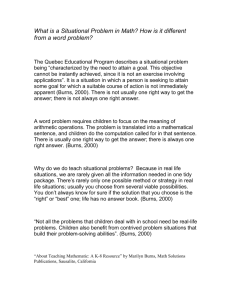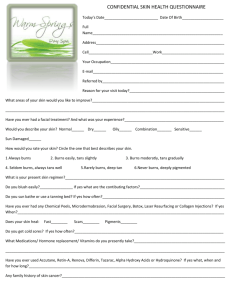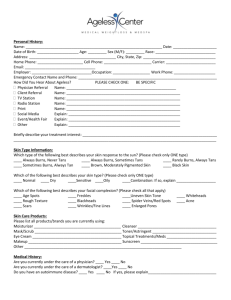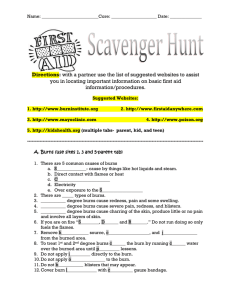Accounting & MIS 3300
advertisement
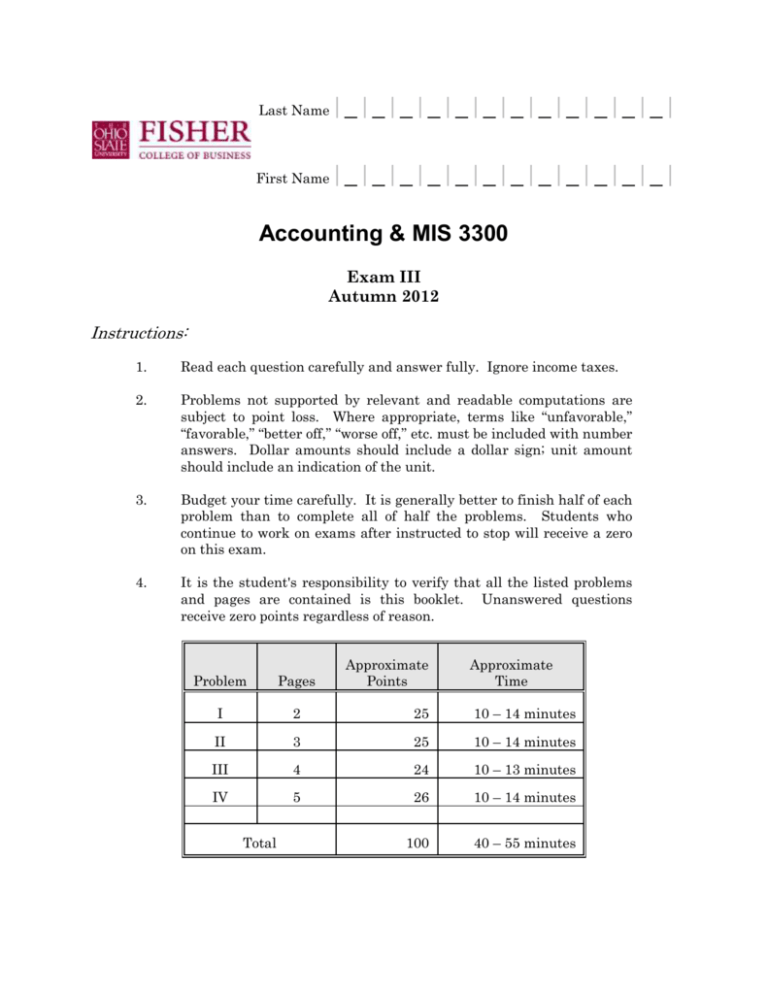
Last Name |_|_|_|_|_|_|_|_|_|_|_|_| First Name |_|_|_|_|_|_|_|_|_|_|_|_| Accounting & MIS 3300 Exam III Autumn 2012 Instructions: 1. Read each question carefully and answer fully. Ignore income taxes. 2. Problems not supported by relevant and readable computations are subject to point loss. Where appropriate, terms like “unfavorable,” “favorable,” “better off,” “worse off,” etc. must be included with number answers. Dollar amounts should include a dollar sign; unit amount should include an indication of the unit. 3. Budget your time carefully. It is generally better to finish half of each problem than to complete all of half the problems. Students who continue to work on exams after instructed to stop will receive a zero on this exam. 4. It is the student's responsibility to verify that all the listed problems and pages are contained is this booklet. Unanswered questions receive zero points regardless of reason. Approximate Points Approximate Time Problem Pages I 2 25 10 – 14 minutes II 3 25 10 – 14 minutes III 4 24 10 – 13 minutes IV 5 26 10 – 14 minutes 100 40 – 55 minutes Total Page 2 of 5 PROBLEM I The Antler Company has two support departments (Cleaning and Maintenance) and two production areas (Assembly and Finishing). The following is known: Actual Costs $ Services Furnished by Cleaning (Sq. footage) Maintenance (labor hrs.) Support Departments Cleaning Maintenance 27,000 $ 96,000 1,000 1,200 Operating Departments Assembly Finishing $ - $ 3,000 600 5,000 3,000 Total - 10,000 1,500 $ 123,000 19,000 6,300 Part A. Allocate the costs under the step-down method that produces an answer closest to the reciprocal method. Part B. Allocate the costs under the reciprocal method. Page 3 of 5 PROBLEM II Burns sells one product at the same price per unit. In 20x1, the results were: Sales Units Sales CGS Gross Margin Operating Expenses Operating Income 45,000 $ 2,970,000 2,565,000 405,000 500,000 $ (95,000) Burns believes that about 60% of Cost of Goods Sold and 100% of Operating Expenses are fixed. Burns expects the results will be the same in 20x2 unless a special order is accepted. Each part is unique, built upon the above data. All special order offers are “take it or leave it.” Part A. Assume a special order for 10,000 units at $45 each is received. Burns has capacity of 64,000 units. How much better or worse off will they be if they accept? Part B. Assume a special order for 10,000 units at $45 each is received. Burns has capacity of 50,000 units. How much better or worse off will they be if they accept? Part C. Burns is considering issuing 10,000 coupons that allow the holder to buy one unit at $58. Burns has capacity of 70,000 units. Burns is concerned that some of the units sold as part of the promotion may replace units they would have sold at the regular price. What is the maximum percentage of the coupons exercised that can come from those who would have bought at the regular price without making Burns worse off? Part D. Burns is considering a special order for 10,000 units when they have capacity of 50,000. Because the customer is in Portugal, Burns would have to pay $45,000 to obtain a one-year export license. What is the minimum Burns is willing to accept from this customer? Page 4 of 5 PROBLEM III Part A. Required: For each of the following cases, place your answer in the box and provide supporting calculations. You have an opportunity to interview with two companies, one in Chicago and one in Phoenix. The airfare to Chicago is $350 and $600 to Phoenix. However, you have combined the trip into one with airfare of $800. You need to allocate the $800 between cities. Indentify four ways to do so and do the allocation: Method of Allocation: Allocated to Chicago Allocated to Phoenix Part B. Required: Compute the optimum production quantity of each product and place your answer in the box and provide supporting calculations. You can produce any combination of three items. However, each uses a $5 computer chip that is in short supply: you can only obtain 100,000. The table below lists the products, the maximum the market will purchase, the number of chips needed, the selling price per unit of final product, and the variable costs to produce that product (but it does not include the cost of the chips used). Product QRS TUV WXY Maximum Chips Sales Needed 20,000 5 10,000 6 5,000 7 Sales Price $50 $60 $70 What should be the production of each to maximize profits? Product Production QRS TUV WXY Variable Costs $13 $10 $17 Page 5 of 5 PROBLEM IV The Baxter Company produces three products, Abc, Def, and GHI, through a joint process costing $72,000. Baxter uses the net realizable value method. Abc is processed further into ABC. Def is processed further into DEF. Abc and Def cannot be sold until further processing. During the first year of operations, the following took place: Kilos Product Produced ABC 800 DEF 400 GHI 2000 Sales Price per Kilo $ 70 $ 90 $ 5 Separable Kilos Sold Costs 600 $ 12,000 300 $ 6,000 1600 $ - Part A. Assume that GHI is treated as a byproduct (production method). requested amounts below: Product Ending Inventory Balance ABC $ DEF $ GHI $ Fill in the Part B. Assume that GHI is treated as a byproduct (sales method). Fill in the requested amounts below: Product Ending Inventory Balance ABC $ DEF $ GHI $
